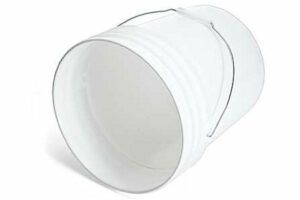Project details
Skill
Cost
Estimated Time
Installing a stone tile floor can transform any room, adding natural beauty to your home. While it requires some skill and patience, laying a stone tile floor is a project many homeowners can tackle with the right guidance. Below, we’ll walk you through the process, from preparation to finishing touches, ensuring you achieve a professional-looking result that will last for years to come.
Understanding Stone Tile Flooring
Before diving into the installation process, it’s essential to understand the basics of stone tile flooring. This knowledge will help you make informed decisions about materials and techniques, setting you up for success in your tiling project.
Types of Stone Tiles
Some of the most popular varieties of stone tiling include the following:
- Granite: Extremely durable and resistant to scratches
- Marble: Elegant with distinctive veining patterns
- Slate: Naturally textured with earthy tones
- Limestone: Soft and porous with a rustic appearance
- Travertine: Known for its pitted surface and warm colors
What Are the Benefits of Stone Tile Floors?
Stone tile floors offer numerous advantages for homeowners:
- Durability: Stone tiles can last for decades when properly maintained
- Natural beauty: Each tile is unique, creating a one-of-a-kind floor
- Increased home value: Stone flooring is often seen as a premium feature
- Versatility: Suitable for various rooms, including kitchens, bathrooms, and entryways
- Easy to clean: Most stone tiles can be easily swept and mopped
What Should You Consider Before Choosing Stone Tiles?
Choosing the right type of stone tile requires considering factors like location, budget, and maintenance.
Location: Different types of stone are better suited for specific areas. For example, granite and slate are ideal for high-traffic areas like hallways and kitchens due to their durability. Marble, while elegant, is better suited for low-traffic areas because it can scratch more easily.
Budget: Stone tiles vary widely in price. While granite and marble may be more expensive, materials like slate and limestone can offer a more budget-friendly alternative.
Maintenance: Each stone type has its own maintenance requirements. Marble and limestone need regular sealing to prevent stains, while granite is more forgiving. Understanding the level of care each stone requires will help you choose one that fits your lifestyle.
How Can You Prepare for Stone Tile Flooring Installation?
Proper preparation is crucial for a successful stone tile installation. This phase involves assessing your subfloor and gathering all necessary tools and materials.
Assessing Your Subfloor
Before laying stone tiles, ensure your subfloor is sturdy and level. If you’re going directly over a subfloor, take these extra steps to prevent cracking or loosening of tiles:
- Stiffen the subfloor by gluing and screwing a second layer of ¾-inch sheathing to the existing layer.
- Install an uncoupling membrane to isolate the rigid stone from the subfloor’s flexing joints and seasonal movements.
Gathering Necessary Tools and Materials
To lay a stone tile floor, you’ll need the following tools and materials:
- Stone tiles
- Uncoupling membrane (e. g., Ditra)
- Unmodified thinset mortar
- Grout
- Utility knife
- Corded drill/driver with mixing paddle
- Notched trowel (¼-inch)
- Grout float
- Margin trowel
- Putty knife
- Sponge
- Cheesecloth
- Tile cutter or wet saw
- Level
- Spacers
 Utility knife
Utility knife Corded drill/driver
Corded drill/driver mixing paddle
mixing paddle Bucket
Bucket notched trowel – 1/4-inch
notched trowel – 1/4-inch Grout float
Grout float Margin trowel
Margin trowel Putty knife
Putty knife Sponge
Sponge Cheesecloth
Cheesecloth
Calculating Material Quantities
Before purchasing your materials, calculate the quantity of tiles and other items you’ll need.
Tiles: Measure the length and width of your floor to determine its square footage. Purchase 10%–15% more tiles than you need to account for cuts and potential breakage.
Thinset and Grout: Refer to packaging guidelines, which usually provide coverage estimates per square foot. Purchase enough to cover your entire floor area.
Other Materials: Buy extra tools like trowels and spacers to account for wear and tear during the project.
How To Lay a Stone Tile Floor Step-by-Step Instructions
Step 1. Cut the Membrane
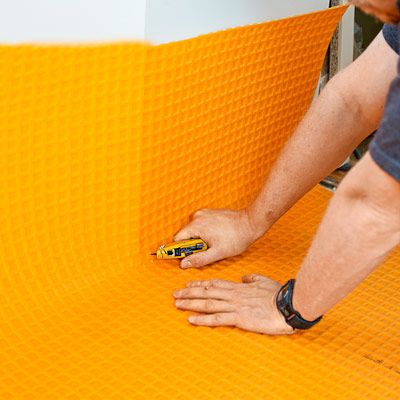
Starting in a corner, roll out the membrane, flocked-side down, beside the room’s long wall. At the end wall, crease the roll into the corner, as shown, and cut along that crease with a utility knife. Trim as needed to get around pipes, ducts, and doorways. Lay out and cut the remaining sections so that their edges butt together and they cover the entire floor.
Step 2. Spread the Thinset
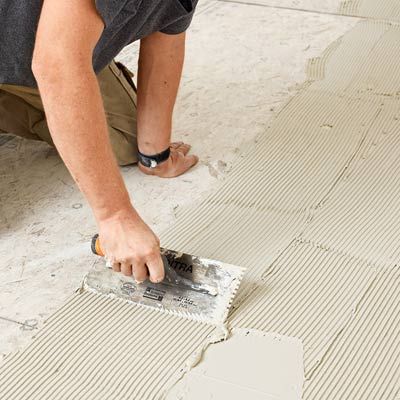
Number the sections, set them aside, then vacuum the floor. Mix a batch of thin-set: Use polymer-modified thin-set on plywood and unmodified thin-set on cement-based substrates. Starting at a corner, spread the mix evenly over a 6-foot section as wide as the membrane, then comb it into long parallel furrows with a ¼-inch notched trowel, as shown.
Step 3. Roll Out the Membrane
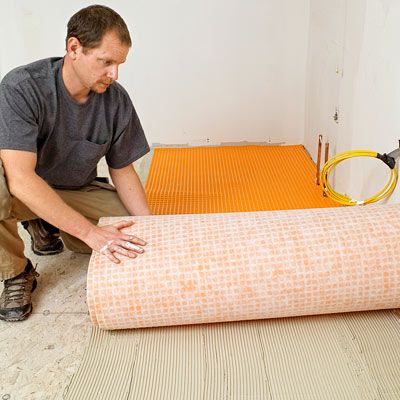
Don’t let the thin-set sit — any delay could prevent a good bond. Butt the first membrane section into the corner and immediately roll it out onto the fresh thinset. Spread and comb out another 6-foot section of thinset, and unroll the next portion of the membrane onto it. Repeat until the first roll reaches the end wall.
Step 4. Secure the Membrane
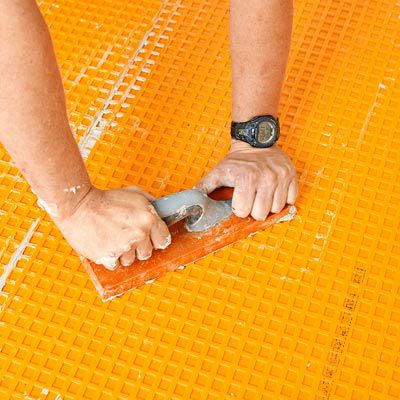
Immediately after the membrane is laid, use a grout float to press every square inch firmly into the thinset, as shown. Do the same after laying each remaining section. Once the entire floor is covered, dry-lay a line of tiles between each pair of walls to judge how best to minimize cuts and get a pleasing layout. Pick a starting point that will keep you from stepping on stones after they’re laid.
Step 5. Lay the Tiles
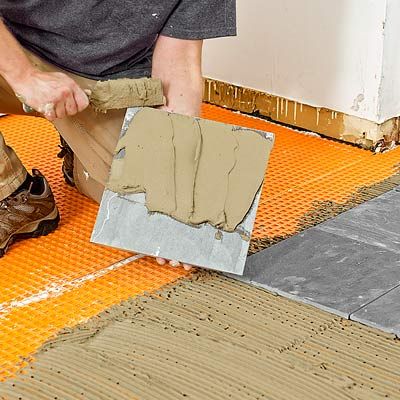
Spread unmodified thinset over an area about 3 feet by 16 inches, filling the membrane’s square dimples. Comb out parallel ridges with the notched trowel. For each tile, smear thinset on its underside, press it firmly in place, and make sure it’s flush with its neighbors and that the joints are even. Gently remove excess thinset from the joints with a putty knife, and swab the stones with a damp sponge.
Step 6. Grout the Joints
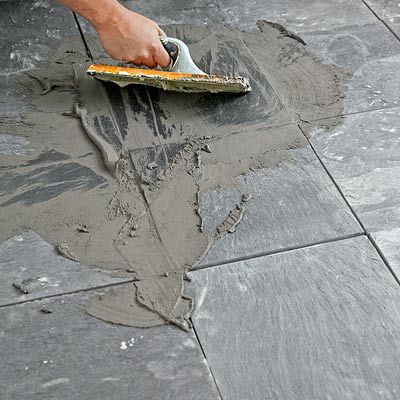
The next day, wash away thinset residue with muriatic acid, and, to protect the stone from grout stains, apply a sealer. When that’s dry, mix up a sanded grout and push it diagonally into the joints with a grout float. Wait 10 minutes, then wipe off grout residue from the stone with a damp sponge, rinsing it often. Don’t disturb the joints. The next day, rub off any haze with cheesecloth and wipe on a final sealer coat.
How Do You Troubleshoot Common Stone Tile Flooring Issues?
Even with careful planning and execution, you may encounter some challenges. Here’s how to address common issues.
Dealing with Uneven Tiles
If you notice uneven tiles after installation:
- For minor unevenness, you may be able to adjust the tile by tapping it gently with a rubber mallet.
- For significant unevenness, you’ll need to remove the tile, clean off old thin-set, and reinstall it.
Addressing Grout Discoloration
If your grout becomes discolored:
- Clean the grout with a pH-neutral cleaner designed for stone and grout.
- For persistent stains, consider using a grout colorant or sealer.
- In severe cases, you may need to regrout the affected areas.
Handling Stone Tile Cracks
Cracks in stone tiles are rare but can occur due to improper installation or excessive force.
Identifying Causes: Determine if the crack is due to a structural issue or a specific event like dropping a heavy object.
Repair: For hairline cracks, use a stone repair epoxy that matches the tile color. For more extensive damage, consider replacing the affected tile.
Prevention: Ensure the subfloor is properly prepared and use an uncoupling membrane to minimize the risk of cracks in the future.
How Do You Properly Maintain Your Stone Tile Floor?
Proper maintenance will keep your stone tile floor looking beautiful.
Daily Care Tips
- Sweep or vacuum regularly to remove dirt and debris.
- Clean spills immediately to prevent staining.
- Use a pH-neutral cleaner specifically designed for stone floors.
- Avoid acidic or abrasive cleaners that can damage the stone or grout.
Long-Term Maintenance Strategies
- Reseal your stone tile floor every 1 to 3 years, depending on use and manufacturer recommendations.
- Have your floor professionally deep-cleaned annually.
- Use felt pads under furniture legs to prevent scratches.
- Place mats at entrances to reduce dirt and grit tracked onto the floor.
Our Conclusion
Installing a stone tile floor is a rewarding project that can significantly enhance the beauty and value of your home. While it requires careful planning and a little time, the result is a durable, timeless floor that can last for generations with proper care.
Remember that if you’re unsure about any part of the process, it’s always wise to consult with or hire a professional. The investment in expert installation can pay off in the long run.




